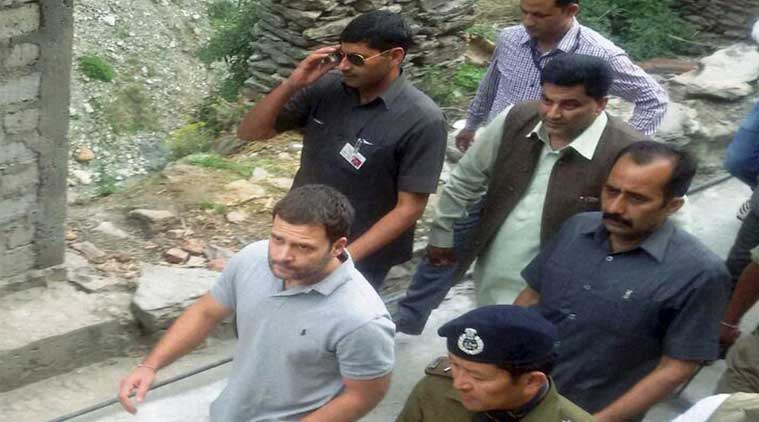Why Rahul Gandhi’s trip to Kedarnath does not surprise
Over the years, the Congress and its first family have harnessed personal faith to their politics.
 Congress Vice President Rahul Gandhi heading Lincholi near Gaurikund on his way Kedarnath on Thursday. (Source: PTI Photo/file)
Congress Vice President Rahul Gandhi heading Lincholi near Gaurikund on his way Kedarnath on Thursday. (Source: PTI Photo/file)
Over the years, the Congress and its first family have harnessed personal faith to their politics.
Congress vice-president Rahul Gandhi appears to be going places. But his Shri Ganesh for this avatar involved a trek to Kedarnath, which evoked some surprise.
But is surprise in order? Maybe not.
Firstly, ‘secularism’ it does not preclude personal faith. It simply denotes the separation of Church and State, or the separation of religious affairs from matters of state, so it doesn’t matter if one believes or not. One can be perfectly secular and perfectly religious at the same time.
[related-post]
Different Congress leaders introduced different slants but personal faith, faith in politics and often, a visible demonstration of personal faith, has been a credo of the party.
William Gould in his Hindu Nationalism and the Language of Politics in Late Colonial India speaks of how in the 1930s and 40s, the terms Hindu and Hinduism were rather fluid, Congressmen often adopted “rhetoric… to local religious and folk traditions but fitted within a homogenizing framework.”
Nearly 100 years ago, the Bal Gangadhar Tilak school of nationalism involved very overtly drawing in religious symbolism and ceremony into the freedom struggle and the terminology used to attack the British.
Gandhi, a deeply religious man, invoked Ram Rajya and other symbols of Hindu religion while forging the widest platform for resisting the British. He engaged with a reluctant Babasaheb Ambedkar to keep the Scheduled Castes within the Hindu fold. Earlier, during World War I, he had wooed Indian Muslims to forge a connect between the Khilafat in Turkey with the Indian national movement. His religious commitment was never in doubt, and despite his prayer book drawing from several faiths, he was proud to be a Hindu and it never detracted from his commitment to ensure that India did not just become a “Hindu Pakistan”.
Jawaharlal Nehru’s commitment to science and rationalism, and his opposition to Rajendra Prasad presiding over the inauguration of the Somnath temple in 1951 set the tone for the Nehruvian approach to religious symbols and politics. He warned President Prasad that the Somnath celebrations “would have a number of implications”. He faced continuous opposition within his own party, from leaders like Purushottam Das Tandon, but pressed on. And yet, as an astute Nehru watcher says, he never minded being referred to as “Panditji”, a phrase that “eased him into the cultural mind of the Hindi-speaking largely upper caste Hindu ethos”.
Indira Gandhi swerved from a radical phase to fanning the ‘soft’ Hindutva sentiment that Sanjay Gandhi personified in an uncut way — with obsessive slogans of ‘population control’ which were then strongly provocative to India’s largest minority.
Personal faith with Indira was Hindu, despite RSS whisper campaigns pointing to her late husband Feroze Gandhi’s Parsi background. The case of the Puri temple denying her entry because she had married outside the faith made waves. The fact however, remained that she saw herself as Hindu.
The return of the Congress in 1980 saw a significantly mellowed Indira. And 1984, according to journalist-author Harish Khare, marked the “first Hindu vote” — pointing to, and sowing the seeds of, the days to come.
Rajiv Gandhi’s move to unlock the doors of the Ayodhya Ram temple, and open the election campaign in Faizabad with a call for ‘Ram Rajya’ made clear, again, the Congress’s lack of hesitation in wanting to tap into a ‘resurgent’, emotional Hindu vote. His government’s compensatory succumbing to the Muslim right on Shah Bano, of course, put paid to that and confounded public opinion.
P V Narasimha Rao unhesitatingly attended and conducted pujas. Congress leaders have patronized temples, have had favourite yajnas and dieties, and have never failed to wear the religious red thread on the wrist proudly to show that they are faithful, and believe in a superior force.
Senior Congress leader Digvijaya Singh takes pride in his ability to both say his mantras and to call out the ‘pseudo-Hindus’.
Perhaps the fact that the UPA was built on the call for a ‘secular’ government, had a Sikh as PM for 10 years, and a Congress president born in a Catholic family, that gave the BJP ammunition to present the Congress as an ‘un-Hindu’ party, and to push it into a tiny corner where it was not Muslim enough and not Hindu at all.
The world’s oldest surviving party has rarely been sectarian in its pronouncements. It has also been ‘in sync’ with the mood of the majority of ‘believers’ — not just Hindu, but also Muslim and Christian. There is a widespread belief within the Congress that it is only if they are in tune with that sentiment can meaningful governance, or even social and political reform, in a complex nation be brought about. Kedarnath was only a small trek to that larger idea, it seems.
- 01
- 02
- 03
- 04
- 05






































